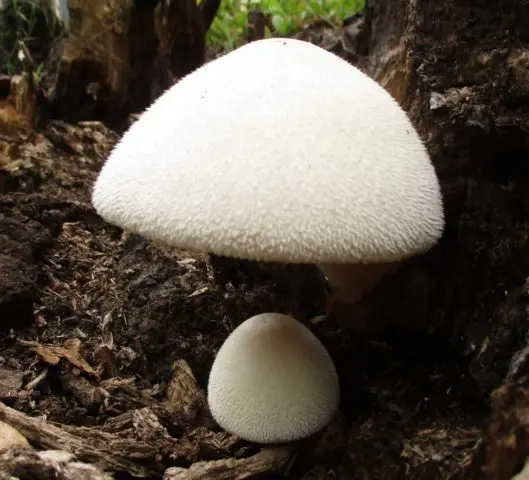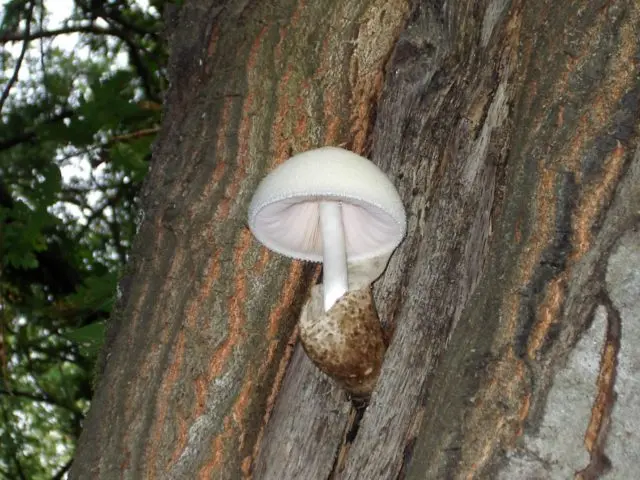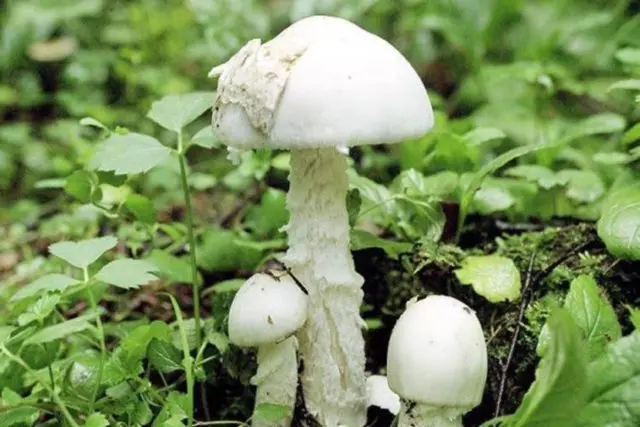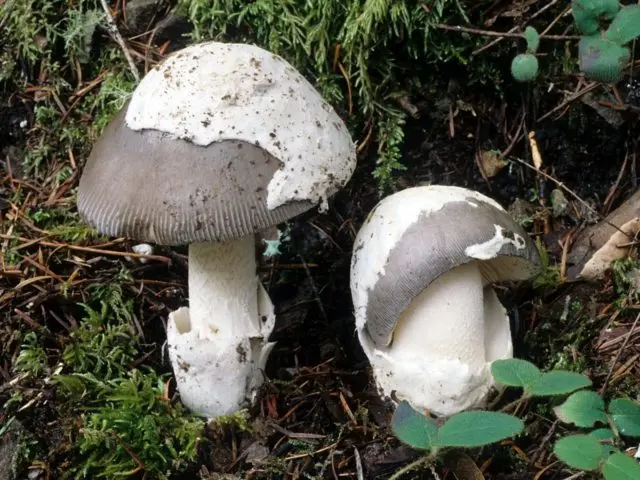Contents
Volvariella silky got its name from the volva, in which the mushroom is enclosed before maturation. Over time, a kind of shell is torn and forms a bag-like cover at the base of the leg. This specimen has another name – Volvariella bombycin. Belongs to the Pluteev family. It is considered one of the most beautiful mushrooms growing on wood. Below is full information about this variety of the genus Volvariella.
What does silky volvariella look like?

The fruiting body of this species is considered the largest of the Plyuteev family, which can grow up to 20 cm. This specimen attracts mushroom pickers with its unusual appearance; it can be distinguished from other gifts of the forest due to the following characteristics:
- The cap of the mushroom is bell-shaped with small scales, the size of which can reach up to 20 cm in diameter. A young silky volvariella has a plastic cap body of white or pale pink color. With age, it becomes convex, flat-prostrate with a brown-grayish tubercle protruding in the center.
- On the lower part of the cap there are loose, soft plates expanded in the middle zone. Their color depends on the age of the fungus. So, in young specimens they are white, gradually acquiring a pinkish-brown hue.

- The leg is smooth, swollen towards the base, the length reaches up to 8 cm, and the width varies from 0,3 to 0,7 cm. As a rule, it is painted white and light gray.
- Spores are ellipsoid, pale pink, smooth.
- The volva is lobe-dissected, membranous and free. It is characterized by a dirty gray or brown color with small brown spots.
- The pulp is thin, dense, white. It does not have a pronounced taste and smell. 3
The development of silky volvariella begins in a kind of egg (volva), with the growth of the fungus, the cover breaks and a specimen with a bell-shaped hat is born, while the leg remains partially wrapped up until the end of its existence. The old mushroom becomes shriveled, flabby, naked, acquires a dark brown color.
Where does silky volvariella grow?
This species is considered quite rare, and in some regions of Our Country and many countries of the world it is listed in the Red Book. So, this copy is under protection in the Republic of Khakassia and on the territory of the Chelyabinsk, Novosibirsk and Ryazan regions.
The main habitat is mixed forests, protected areas, natural parks, grows well on weakened or dead deciduous trees. Prefers maple, willow, poplar. Mostly appear singly, but sometimes unite in small groups. Active development is observed in the period from July to August, however, it also occurs until late autumn. It is a drought tolerant mushroom that tolerates heat well.
Is it possible to eat silky volvariella
Volvariella silky is categorized as an edible mushroom. As you know, experienced mushroom pickers do not have a question about the use of this species, they claim that such a specimen is suitable for consumption. But before being used for food, the gifts of the forest must be processed. To do this, they are pre-boiled for about 30-40 minutes, after which the water is drained.
False doubles

Due to its peculiar appearance, silky volvariella is quite difficult to confuse with other representatives of the forest. But inexperienced mushroom pickers may not distinguish the specimen in question from the following representatives of the forest:
- White (stinky) fly agaric. It is worth noting that this species is poisonous, so it is very important to carefully study the specimen and if there is any doubt about its edibility, it is better not to take it. You can distinguish silky volvariella from stinky champignon thanks to the grayish “fleshy” hat and pink plates. In addition, the latter is the owner of a ring on the leg, and this species does not have it. Another main difference is the location of the gifts of the forest. Volvariella silky is not found on earth, it grows exclusively on wood, which is not typical for most mushrooms.

- Float gray – a representative of the genus Amanita. It is considered a conditionally edible mushroom, but it does not particularly attract potential customers because of its appearance and thin pulp. Unlike volvariella, this silky specimen is much smaller in size. So, the diameter of the cap varies from 5 to 10 cm, and the length of the leg is no more than 12 cm. The spore powder is white. Although this species grows in deciduous and mixed forests, like volvariella, it is found exclusively on the ground.

Rules for collection and use
It is not recommended to pull out and unscrew the volvariella, since the fruiting body can simply crumble, and there is a chance of damaging the mycelium. Therefore, experts advise carefully cutting off the leg with a knife.
As a rule, only hats are used for food, since the legs are harsh. Before preparing the mushroom dish, silky volvarella is cleaned of debris, washed and boiled for 40 minutes. Mushroom broth is not recommended for food.
Most mushroom pickers claim that after preliminary cooking, this type is suitable for almost any dish. Volvariella silky can be stewed, fried, boiled and pickled.
Conclusion
Volvariella silky is an exclusively tree fungus. It can be found on old and rotten stumps, logs, on the trunks of living or dry trees, even in hollows. Due to the unusual color and “hairy” hat, this representative of the Volvariella genus is quite easy to distinguish from his relatives.












